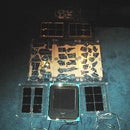Introduction: Nice Easy Magnetic Generator Light
People look like they are having a good time charging up those other magnetic torches but it's definitely more fun to watch. This one may require 2 hands but at least you can go all night if you want to.
All you need is a stepper motor and some White LEDs, but a handle is optional.
If you think you have a stepper motor but aren't sure, turn it and see if you can feel the steps.
This motor came out of a big old floppy diskette drive but I think they are very common in other stuff
I took apart, like printers.
A resistor is probably a good idea because it's so easy to make power that you can burn out the LEDs.
It's easy to find the wires on a stepper motor that will light up an LED
but soon I'll show a good way to connect several.
Sorry about the blurry picture I'll update this and fix it soon.
Ok here it goes, this is one time that it's nice that the camera takes so long to take a picture.
I just fixed it up a bit and found something like a propeller to crank it with too.
And dont get mad... because that finger is not the one it probably looks like.
Step 1: Step 1
Under construction.
I know I'm being bad but the magnet contest is almost over.
The schematic below is basically how I have the stepper hooked up now.
The diodes are white LEDs. The resistors are not there yet, so sometimes the LEDs blow.
The resistors will probably be 100 or 470 ohms.
They may be moved off the center tap because they really belong in series with each LED.
I may add reversed LEDs in parallel to get twice as much light,
but then I expect the motor to be harder to turn.
There was a crank on the motor but someone broke it off.
It was just a wire with a loop at the end to put a finger in and go around in circles.
This particular motor can blow LEDs without the crank which is why I didn't bother fixing it Yet.
It's pulley can be turned instead.
Stepper motors may have 4 (no center taps) or 5 (common center taps) or 6 (2 center taps)
in their stator coils. The rotor is a magnet with lots of virtual north and south poles so that
there are a lot more than 4 steps per revolution. Too many to count easily. It seems to have
end pieces with lots of teeth.
Figuring out the wires can be done with a meter. Except for the 5 wire motors there is
no voltage or continuity between the two coils. The center taps will have half as much voltage
or resistance than just the ends of the coils.
For 4-wire motors you can't just have 2 LEDs facing each other like this,
need to reverse the polarity of one (and maybe put it in parallel with the other one,
and leaving out that LED is another option).
Summary, you can easily connect up to 8 LEDs to the stepper motor to use all of it's power generating phases,
but you can also get the LEDs to light just by trying different wires,
and current limiting resistors seem practical and essential.
A hand crank, or a pulley with a finger-hole in it is very good too,
because otherwise just turning the shaft gives annoying pulsing light output.
This does not "charge up". It produces light as soon as you turn it, and until you stop.
But it could... batteries or capacitors may be added. Maybe I will do that later.
Step 2: Afterthoughts
I guess I decided that the schematic I made on the last page is good, and 100 ohm resistors are good.
It is bright enough to see and walk around outside in the woods at night as long as I don't drop it.
(Maybe I should put phosphorescent matter on it so I can find it in the dark.)
I am very surprised at how easily the steppers make a useful amount of light compared to real products.
I guess later I'll make one that uses a 4-wire stepper, draw another schematic for it,
and maybe add a couple more sharper pictures of both lights that clearly show the works.
Tired... more later. Oops, sorry, I guess this is it.













